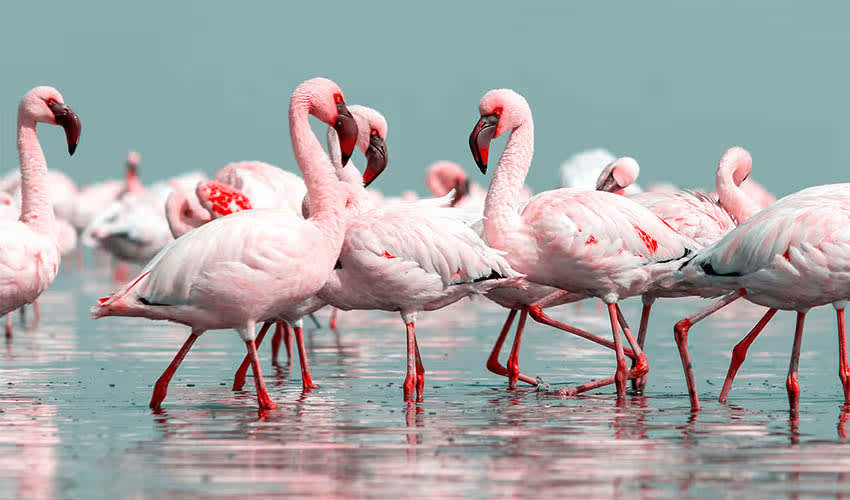The most widespread and largest species of the flamingo family. Found in parts of Africa, southern Asia (including India), the Middle East, and southern Europe, this species is noted for its striking pink plumage, long, lean, curved neck, and similarly lengthy and slender legs.
During the breeding season, the plumage of Greater Flamingos becomes more vibrant. The intensity of their pink coloration is diet-dependent, with pigments known as carotenoids (found in their natural food sources like shrimp, plankton, and algae) playing a crucial role. Additionally, these flamingos engage in a unique behavior known as “make-up” where they use their uropygial glands to spread pigmented oil over their feathers, enhancing their coloration. This cosmetic application not only intensifies their hue but may also be a factor in mate selection.
Greater Flamingos are gregarious birds that find strength in numbers. They form large colonies that can number in the thousands, which offers individual birds protection against predators. Within these colonies, birds often form smaller groups that engage in synchronous nesting and cooperative vigilance, ensuring the safety and survival of their offspring.
The young flamingos hatch with gray feathers and do not acquire the characteristic pink plumage until they are about two years old. The coloration process is gradual and correlates with their maturing diet, which begins to include more carotenoid-rich foods.
Distribution
 Afghanistan
Afghanistan Algeria
Algeria Angola
Angola Armenia
Armenia Austria
Austria Azerbaijan
Azerbaijan Bahrain
Bahrain Bangladesh
Bangladesh Belarus
Belarus Belgium
Belgium Botswana
Botswana Bulgaria
Bulgaria Burundi
Burundi Cambodia
Cambodia Cameroon
Cameroon Cape Verde
Cape Verde China
China Cocos Is. (Keeling)
Cocos Is. (Keeling) Comoros
Comoros Congo-Brazzaville
Congo-Brazzaville Croatia
Croatia Cyprus
Cyprus Czechia
Czechia DR Congo (Kinshasa)
DR Congo (Kinshasa) Denmark
Denmark Djibouti
Djibouti Egypt
Egypt Equatorial Guinea
Equatorial Guinea Eritrea
Eritrea Eswatini
Eswatini Ethiopia
Ethiopia Finland
Finland France
France Gambia
Gambia Germany
Germany Gibraltar
Gibraltar Greece
Greece Guinea-Bissau
Guinea-Bissau Guinea
Guinea Hungary
Hungary India
India Iran
Iran Iraq
Iraq Islands
Islands Israel
Israel Italy
Italy Jordan
Jordan Kazakhstan
Kazakhstan Kenya
Kenya Kuwait
Kuwait Kyrgyzstan
Kyrgyzstan Latvia
Latvia Lebanon
Lebanon Lesotho
Lesotho Libya
Libya Madagascar
Madagascar Malawi
Malawi Maldives
Maldives Malta
Malta Mauritania
Mauritania Mauritius
Mauritius Mayotte
Mayotte Mongolia
Mongolia Montenegro
Montenegro Morocco
Morocco Mozambique
Mozambique Namibia
Namibia Nepal
Nepal Niger
Niger North Macedonia
North Macedonia Norway
Norway Oman
Oman Pakistan
Pakistan Poland
Poland Portugal
Portugal Qatar
Qatar Romania
Romania Russia
Russia Russia
Russia Réunion
Réunion Saudi Arabia
Saudi Arabia Senegal
Senegal Serbia
Serbia Seychelles
Seychelles Sierra Leone
Sierra Leone Slovakia
Slovakia Slovenia
Slovenia Somalia
Somalia South Africa
South Africa Spain
Spain Sri Lanka
Sri Lanka Sudan
Sudan Sweden
Sweden Switzerland
Switzerland Syria
Syria São Tomé & Príncipe
São Tomé & Príncipe Tajikistan
Tajikistan Tanzania
Tanzania Tunisia
Tunisia Turkey
Turkey Turkmenistan
Turkmenistan UAE
UAE Uganda
Uganda Uzbekistan
Uzbekistan Yemen
Yemen Zambia
Zambia Zimbabwe
ZimbabweAnything we've missed?
Help us improve this page by suggesting edits. Glory never dies!
Suggest an editGet to know me
Terrestrial / Aquatic
Altricial / Precocial
Polygamous / Monogamous
Dimorphic / Monomorphic
Active: Diurnal / Nocturnal
Social behavior: Solitary / Pack / Herd / Flock
Diet: Carnivore / Herbivore / Omnivore / Piscivorous / Insectivore
Migratory: Yes / No
Domesticated: Yes / No
Dangerous: Yes / No






